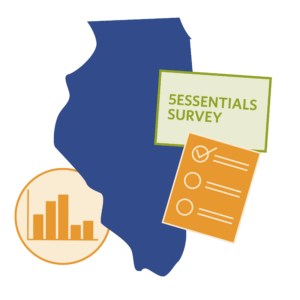In Illinois, the student survey is part of the state’s formal accountability system and also contributes to schools’ own improvement efforts. 5Essentials (5Es) Survey results signal to educators, parents and community members the importance of considering both school culture and student perspectives on learning in any effort to raise student outcomes.
Elevate the importance of school culture, climate, community resources and engagement in addressing disparities and improving student success.

Watch a video about how education leaders are using these indicators in Illinois.
This survey of students, families and educators measures the presence of five essential elements in schools that have been shown to positively influence student learning and school improvement efforts. These are effective leaders, collaborative teachers, involved families, supportive environment and ambitious instruction.
Survey results correlate with students’ attendance, test score gains, whether they are on track for graduation, and actual graduation rates.

The 5Es Survey measures the five5 essential elements needed to effectively implement school improvement efforts.
“When we have diverse populations; different cultures need different things. Looking at the 5Es Survey helps us listen to students, improve upon their experiences and actually enhance academic achievement.”
Chicago schools began using the 5Es Survey nearly 20 years ago. Illinois policymakers chose to incorporate this survey into the state’s accountability system for all schools in 2017. A handful of other states have tapped different student surveys or climate measures to be part of their accountability systems. What distinguishes Illinois’ use of the 5Es Survey is the assessment of those parts of school climate, culture and community engagement that research shows influence student learning.
Strong 5Es Survey results, regardless of demographics, correspond with higher student achievement. In 2010, the UChicago Consortium on School Research found that schools with high ratings in at least three of the five essential elements were 10 times more likely to show substantial gains in student learning than those weak on three or more. The Consortium’s research also revealed that a persistently low score in even one of the five areas reduced the likelihood of improvement to less than 10 percent. Additional research has reaffirmed these findings.
Over time, the 5Es Survey has been administered in thousands of Illinois schools and hundreds of districts. Nationally, it has been used in 22 states and more than 6,000 schools, with 10 million students, parents and teachers taking the survey.
The 5Es Survey results are used in multiple ways within the Illinois accountability system. The results are displayed in school report cards (showing how survey respondents rate their school’s implementation of each of the five essentials). They are intended to inform improvement efforts by helping educators target strategies and resources to areas known to be related to increases in student learning. In addition, the Illinois State Board of Education (ISBE) publishes the survey participation rates results for every school and district and factors student participation rates into its identification of struggling schools.
“Adults can sometimes be rather good at telling students what their problems are and what the solutions, but we’re not as good at listening to students and what they have to say. The 5Es Survey takes student voice into account.”
Districts are using survey data to address inequities with varying degrees of success. Some educators have suggested the state’s past presentation of 5Es Survey data has been difficult to interpret and use. In response, ISBE revamped survey reports starting with the 2023–24 school year to make the results more actionable. While Illinois provided strong communications support and technical assistance when the survey was first rolled out statewide, some district leaders and teachers also suggest more specific resources would be useful today. ISBE currently provides a few online templates to incorporate survey data into schools’ improvement plans.
“As soon as any policy is made, people better start thinking about implementation. I think a mistake we made in Illinois is that we should have put in place more structures and supports for schools to use the survey results.”
Reflecting on deep work with a variety of Chicago schools in 2006, researchers at the UChicago Consortium on School Research proposed five organizational domains or “elements” that contribute to improved student achievement. These five elements include:

Principals and teachers work together to implement a shared vision for sustained improvement. Leaders practice shared leadership, set ambitious goals for quality instruction, maintain trusting and respectful relationships, and support professional advancement for faculty and staff.

All teachers collaborate to promote professional growth and are active partners in school improvement. Teachers are committed to the school and focused on professional development.

The entire school staff builds strong relationships with parents and guardians and sees them as partners in helping students learn. Family input and participation are valued in advancing the school’s mission.

The school is safe, challenging and supportive. Students feel safe in and around the school, and they find teachers trustworthy and responsive to their academic needs. Students value hard work, and teachers push all students toward high academic performance.

Classes are rigorous and engaging. The instruction is clear, well structured, aligned across grade levels, and encourages students to build and apply knowledge. When combined with a supportive environment, ambitious instruction has the most direct effect on student learning.
To support educators in applying these research findings, UChicago Consortium researchers created the 5Es Survey to solicit the views of educators, families and parents, and students on the strengths and weaknesses of their school in the five areas.
“The information in the 5Es rests on a well-documented and researched understanding of what needs to be happening at a school in order for it to successfully ensure student academic progress. It considers the level of ambitious instruction and how students experience their time in school.”
The survey measures the vigor and stability of school culture and academic environment. It asks students, teachers and families to share perceptions of their school’s culture, climate and community. In focusing on these experiences, the survey poses questions, such as: Do students find their classes academically challenging? Are teachers working together to support student success? Are parents welcomed and engaged?
While the survey is administered to all three groups of stakeholders and the results from all three are shared publicly, the state’s accountability system uses only the student participation rates (along with other indicators) to identify struggling schools.
“It’s not a panacea or a magic wand in and of itself. It doesn’t solve every challenge one might have. But it certainly creates the conditions that enable you to maximize what you’re able to do.”
For more than two decades, the UChicago Consortium has worked closely with city leaders and Chicago educators to strengthen improvement efforts. They focused closely on schools with traditionally poor student outcomes Early versions of the survey informed these efforts and, by the mid-2000s, researchers began recognizing enduring patterns in buildings most successful at improving student learning. Looking deeply at the data, they investigated why students in 100 public elementary schools in Chicago were able to substantially increase reading and math outcomes over a seven-year period while students in another 100 schools were not.
Researchers synthesized their findings into “five essentials” that could guide education leaders. They formalized what is now the 5Es Survey to clearly measure these elements. Chicago Public Schools embraced the new tool at the time as a way to gather feedback from a school’s community and support principals to lead improvement strategies.
“If your climate and culture as measured by the 5Es Survey is strong, then you would have a strong expectation to see improved student outcomes over time.”
Illinois legislators then directed ISBE to adopt a survey of learning conditions. They wanted to give teachers and students statewide input on their school’s environment. After a broad search, ISBE selected the 5Es Survey to be implemented beginning in the 2012-13 school year, in part because of its strong evidence base from Chicago.
To expand transparency, ISBE began reporting survey results for all Illinois schools in 2014. Then, when federal rules changed for accountability systems a few years later, Illinois used the opportunity to make students’ survey rates a formal measure. By 2021, Illinois was one of nine states that used some sort of school climate survey in its accountability system.
In 2018, the state began using survey participation rates of students as one consideration in its process for identifying struggling schools. Illinois leaders chose to hold schools accountable for 5Es Survey participation rates as opposed to using actual survey ratings as a way of building broader support for the new indicator and to incentivize educators to collect the data even if some of the results were negative. (ISBE covers districts’ costs for using the 5Es Survey, however districts are able to apply for a waiver to administer and pay for a different student survey that can be demonstrated to measure similar elements, which some Illinois districts have done.)
“The 5Es Survey has a great deal to offer a school, but the administration, both at the building and district levels, as well as the teachers union, really needs to be comfortable and skilled at using the data.”
With 5Es Survey data, districts and schools are identifying where disparities exist and making changes. Importantly, this focus includes how students from different racial and ethnic groups experience classroom teaching and a school’s overall climate. For example, University of Chicago researchers found that schools in neighborhoods with higher poverty typically have lower measures of students who report feeling safe, teacher satisfaction with parent involvement, and overall teacher/parent trust and commitment over time. These differences create additional obstacles to learning and success for students who may be struggling, but they are also conditions that educators, parents and communities can work to change.
“If we have students who aren’t feeling safe at this particular building, we need to address that reality. While that doesn’t directly lead to student achievement immediately, it will eventually help because we are creating a more supportive environment for learning to happen.”
Making the 5Es Survey part of Illinois’ accountability system has increased student outcomes, when districts invest time and resources in schools using the results. While most observers say use of survey results has been uneven across Illinois, both quantitative and qualitative research suggests that the results are impactful where the data have been used intentionally. The data also are identifying how school cultures in high-income and low-income neighborhoods diverge and inform better targeting of resources and supports.

The 5Es Survey results are positively correlated with common outcomes of student success.
Schools with weaker 5Es scores have improved over time. UChicago Impact, a nonprofit organization created to disseminate and support greater use of the 5Es Survey and other research-based school improvement tools, spotlights several of these successes in case studies. These profiles describe how schools with challenging 5Es Survey ratings have changed through actions such as reorganized teacher planning time, revamped student discipline policies, clarified student expectations and greater attention to teacher/student relationships.
“State leaders wanted to ensure that they were being able to have schools participate in a meaningful way and get the data needed in order to spark conversations around school improvement.”
The 5Es Survey is directly linked to five research-based elements within school culture, climate and community. By giving educators, parents and other stakeholders insights into strengths and weaknesses in each of the five areas, survey results can chart a path to greater success.
Survey results play a dual role in Illinois’ accountability system. As a publicly reported metric, they signal the importance of schools paying attention to the learning environment in addition to achievement results—and to considering how students themselves are experiencing their learning. They also provide actionable data to support educators and communities in strengthening climate and culture to improve student achievement.
“Getting the survey results is like holding up a giant organizational mirror and reflecting it back to the community and saying ‘This is an area where our current efforts have paid off and here is area that is targeted for attention.”
Illinois is elevating the direct perceptions and experiences of students themselves. By way of publishing and counting student participation rates in the 5Es Survey, the state has attached stakes to the data to reinforce their importance. While federal law dictates many of the measures to include in states’ accountability systems, it does provide flexibility for states to choose a measure of school quality and student success. Illinois is one of the few states that chose an indicator for this flexible area that taps student insights into their education.
“We wanted to reflect students’ participation in the survey in the accountability system so that district decisions were at least informed by student voice, if not driven by them.”
The Survey demonstrates how the use of climate and culture measures can lead to success. Education First chose to profile the 5Es Survey because we were interested in whether including a leading indicator in a state’s formal accountability system alongside more traditional lagging measures, such as test scores, attendance and graduation, could provide actionable improvement data, too. We also appreciated the survey’s emphasis on elevating the voices of students, parents and classroom educators.
As Illinois and other states interested in using school climate and culture indicators move forward, several issues will take further work to solve:
Ensure school climate and culture data really do contribute to improvement strategies. Evidence suggests that incorporating 5Es Survey data as part of a larger strategy to direct resources and support decision-making could increase student outcomes. However, doing so requires a clear rationale of and ongoing communications about how the tool fits into the state’s accountability system and how schools are using findings to tangibly improve.
“Figure out how the information from the survey fits into the constellation of other data points that you are collecting to build a comprehensive overarching narrative about what is happening in a school.”
Provide more tools, support and coaching to educators, both at the beginning and following survey implementation. Although Illinois pays for every district to administer the 5Es Survey, state leaders and advocates suggest the state has not been able to sustain paying for training and resources for all. Sustaining this sort of assistance and having a plan and resources to do so could support educators in better understanding the tool and its data—and maximize their use.
Review the data with an open mindset. School improvement requires openness by leaders to truly assess what is and isn’t working in their districts. In particular, insights into climate, culture and community, which school and district leaders can directly influence, can be unsettling. Building educator trust as findings are examined is essential for success.
“This process pushes us to have dramatically different conversations about schooling. This is a radically different orientation to the way one usually thinks. And that’s deeply hard and uncomfortable work. It requires working with people through that and helping support them, as leaders, to be vulnerable.”
Learn more about the 5Es Survey and how it measures school culture and climate:
To see the actual survey questions and survey data, review the following resources:
To learn more about the research base and evidence supporting the efficacy of the 5Es Survey, review the following reports:
